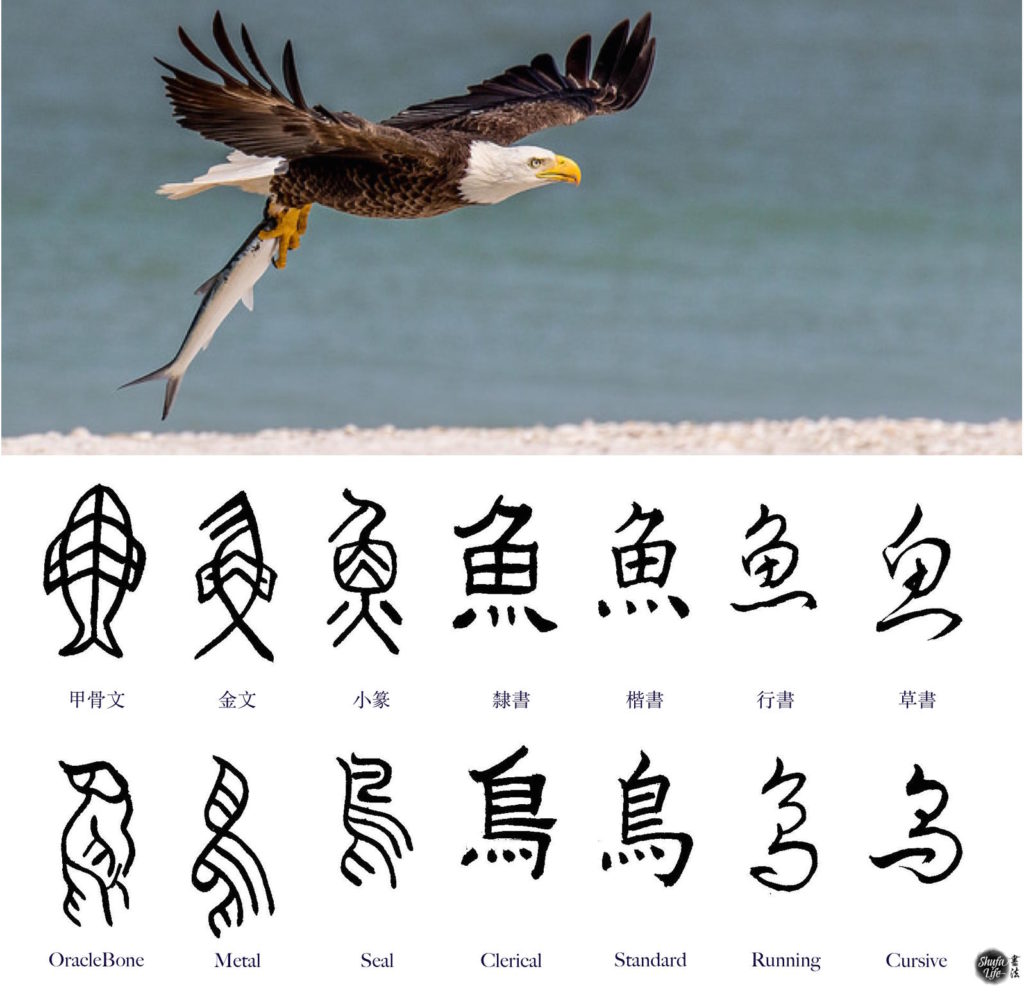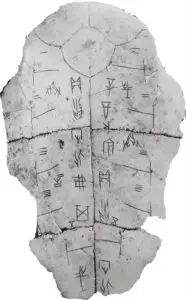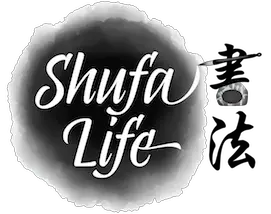Chinese calligraphy fonts have evolved from pictographs to modern day Chinese symbols. A classic example of the various scripts in Chinese writing comes from the characters for fish and bird:

Background Photo credit
Ancient Chinese characters were developed after a scholar Cangjie, supposedly from prehistoric times, noticed that claw prints left by birds and animals could be used for writing. Now we know why there’s a Cangjie type font.
Calligraphy has a history of over 3000 years, initially often mimicking imagery closely. In modern times, the latter 5 types of calligraphy are the most commonly practiced ways of writing: 小篆(xiǎozhuàn) Small Seal script, 隸書 (隶书lìshū) Clerical Script,楷書 (楷书kǎishū) Regular script, 行書 (行书Xíngshū)Running Script,草書(草书cǎoshū) Cursive script.
Regular or standard script is most common, with most signs and plaques carrying the telltale structure of this script. Seal scripts are used on ink seals (stamps) widely used in China for important documents or art. Day to day, the cursive fonts are popular for letters or self expression, though you may need calligraphy translation services if not familiar.
Ancient Chinese Symbols
甲骨文 (Jiǎgǔwén) Oracle Bone script was carved onto animal bones and tortoise shells, appearing picturesque, linear, and narrow. They were a communication method with the gods; in fact early markings have been discovered as early as the neolithic age of 5000 BC. Archaeological finds date thousands of oracle bones to the Shang dynasty period, roughly between 1722-1291 BC. Over 5000 characters have been noted, with about a third of those recognized as words.

oracle bone inscription
金文 (jīnwén) literally means “words on metal“, referring to engravings on ancient bronze vessels. This script was popular throughout the Zhou period and became more orderly in size and form, though still highly decorative. Markings were first carved and then cast in iron. The nature of the writings were more official in nature, recording rituals, contracts, and important business. (side note-Technically 金文 can be lumped in with into 大篆 or great seal script, which was eventually unified into small seal script)
Styles Still in Use
小篆(xiǎozhuàn) Small Seal script was developed under the reign of the great Yellow Emperor(Huángdì) of Qin dynasty, (221 to 206 BC) which was considered the first imperial dynasty. The Yellow Emperor not only unified vast swaths of China, but managed to standardize the Chinese writing system. For thousands of years Chinese calligraphy was synonymous with Chinese writing-all writing was done with a brush.
Seal script is highly stylized but decorative in comparison with the later scripts that followed, though beginning to look more like symbols. The red inked seal on a Chinese calligraphy scroll is usually in seal script.
隸書 (隶书lìshū) Clerical script was initially developed by Cheng Miao (3rd century BC), who was actually imprisoned by the authoritarian Yellow Emperor. It was in prison that the clerical script was formed, and as a result the “lì” in lìshū is sometimes translated as “convict”, even though it can also mean “clerk” or “petty official.” Clerical script gained favor as a faster way to write than seal script, which government officials found useful as their recording responsibilities grew.
The development of 隸書 lìshū marked a significant shift in writing. The circular forms of previous script were pulled into more vertical and horizontal lines, resulting in the square character form that still holds true today. Even the motivation behind writing evolved, from mostly ceremonial or spiritual purposes into furthering secular interests.
楷書 (楷书kǎishū) Regular/standard script generally has shorter strokes and is considered the most legible. Developed around the second or third centuries, the characters remain the standard script in modern day. The regular script written by calligrapher Chung Yu (151-230) was considered the gold standard, later copied by renowned calligrapher Wang Hsi-chih (307-365). Calligraphy finally was flourishing as a standalone art, instead of simply a tool to communicate with the gods. Human ingenuity was being celebrated through art.

small standard script, a college production from our head curator
Most calligraphy writers learn a foundation in standard script before moving onto the cursive forms. 行書 (行书Xíngshū) is referred to running script because the literal translation is “moving script” or “script in motion.” Wang Hsi-chih’s work is once again considered model calligraphy, but many artists have added their own personal variations and interpretations to the art. Painters and calligraphers alike appreciate the flowing, casual style, which lends itself to fast and frequent usage. Strokes are more linked and fluid, adding life to the characters.
草書 (草书cǎoshū) Cursive script has the air of a hurried scribble, and was essentially a fast,cursive form of clerical script, used around the same times in the Han dynasty. There are further sub classifications that vary in forms of connectedness of the strokes. For a typical beginner learning of Chinese, these scripts can be virtually undecipherable.
Chinese written word continues to carry significance and beauty beyond the meaning of each character. Take another look at the evolution of the word “bird.” What’s your favorite style?
